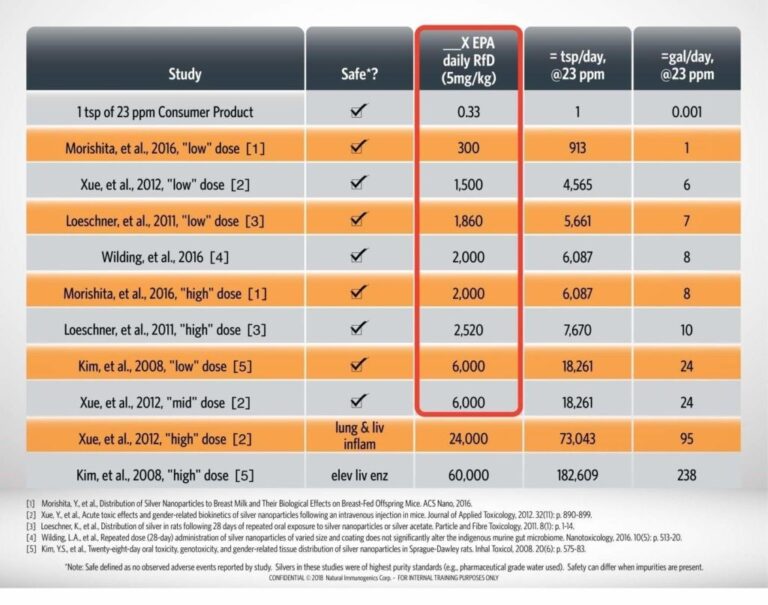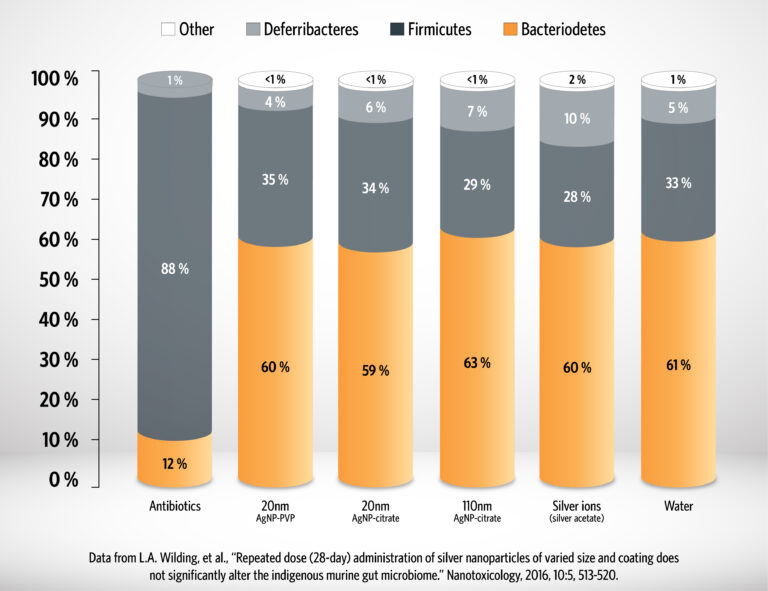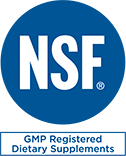FAQs
GENERAL QUESTIONS
How can I order Argentyn 23 Products?
Are elemental (neutral) particles of silver (AG) more effective than positively charged silver?
The scientific literature states that it is the free silver ions (i.e. the positively-charged species) that are active and that there is a "negligible particle-specific" effect. [6] In fact, researchers found that "the biological activity of nanosilver has been attributed to the associated silver cation and its soluble complexes." [7]
Why is Argentyn 23 Bio-Active Silver Hydrosol clear in color while most other silver products are not?
Silver colloids have a color based on their particle size, ranging from orange to brown to yellow to clear as their size decreases. The property is called Surface Plasmon Resonance. Particles smaller than 5nm are "subplasmonic" meaning they are clear and colorless solutions. Argentyn 23 Bio-Active Silver Hydrosol is a mixture of positively charged silver ions and silver nanoclusters with particles as small as 0.8 nm (nanometers). Color is visible when particles are longer (above 5 nm). A larger quantity of particles can also lead to visible yellow color as more particles absorb more light. Darker color is an indication of one or more of the following: even larger particles, compounds (salts or proteins), reduction of bio-active silver ions, or impurities. A smaller particle size is desirable due to greater surface area available for conversion to bio-active silver. Since visible color is an indication of larger particles, then visible color is your visual cue to less effective silver products.
Are other silver products with higher concentrations (higher ppm) more powerful?
No. More is not always better. What makes one silver product more effective than another is not its PPM concentration, but rather its particle size, positive charge, form and purity. The smaller the particle, the more bioavailable it becomes, and the greater the surface area available for conversion to positively-charged, bio-active silver while within the body.* Argentyn 23 Bio-Active Silver Hydrosol has an unprecedented particle size as small as 0.8 nanometers.

Can you provide information on safety, side effects and adverse effects of Argentyn 23 Bio-Active Silver Hydrosol?
Safety:* Argentyn 23 is marked as a dietary supplement under DSHEA. Federal agencies responsible for the protection of communities from harmful health effects related to exposure to natural and man-made hazardous substances, such as the Environmental Protection Agency (EPA) and the Agency of Toxic Substances and Drugs Registry (ATSDR) for example, have issued several risk assessments for Silver, and have established a Threshold of Toxicity Concern (TTC) of 350mcg/day for an average adult of 70Kg (for silver ingestion). Our suggested dosage of up to 3 tsp. a day as labeled, is based on these assessments; therefore, we can say that Argentyn 23 Bio-Active Silver Hydrosol is safe* when following these label directions, or use as directed by a healthcare professional. In addition to the above, a summary of peer-reviewed literature studies on ionic silver and colloidal silver (silver nanoparticles) is presented in the table below. [1-5] No observed adverse events are reported until 24,000X the EPA daily reference dose (RfD) of 5 micrograms of silver per kilogram of bodyweight. It is critical to note that all literature studies used high purity water, high purity silver materials, and endotoxin free materials. The purity of Argentyn 23 exceeds the standards used in these studies, thereby allowing interpretation of this literature with confidence. The presence of other ingredients in the formulations or other contaminants can dramatically impact the safety profile of other colloidal silver products.
SAFETY
Can long-term use of Argentyn 23 Bio-Active Silver Hydrosol damage cells?
No. In order to exhibit long term damage, mammalian cells require silver exposures that are several orders of magnitude in excess of Argentyn 23 dosages. [9][10]
Does Argentyn 23 Bio-Active Silver Hydrosol have a taste?
Argentyn 23 Bio-Active Silver Hydrosol tastes like water, although sometimes people report detecting a faint metallic taste. This faint metallic taste might feel stronger, usually due to the pH of the mouth when the product was ingested. For example, if you recently drank coffee or orange juice, which are highly acidic, you might be more apt to detect the faint metallic taste. Metabolic changes, such as acidic saliva (most likely due to changes in diet of from dietary choices) could result in a change in the pH of your saliva, which may cause Argentyn 23 to taste stronger (bitter/sour/pungent) than "water with faint metallic taste". A secondary cause could be leaching of metals from dental amalgams. However, leaching usually only occurs when the saliva is acidic, this pointing back to a dietary change. You can easily find lists of alkaline foods on the internet. Organoleptic (taste & odor) tests are part of our Quality Control batch release parameters. Our products is manufactured in an NSF-certified GMP facility in the same exact way with the same exact components, each and every time, and we have never released a "bad" batch.
Is it possible to overdose?
Not on the silver in Argentyn 23 Bio-Active silver Hydrosol. The amount of water ingested to get to a level of toxicity from silver in Argentyn 23 will cause a toxic response long before silver does. According to the peer-reviewed literature, observed acute toxicity events of liver and lung inflammation are reported at 24,000X and 60,000X the EPA Reference Dose of 5 mcg of silver per kg of body weight, which would require ingesting over 93 gallons of Argentyn 23 for a 70kg adult. [4, 5]
Can Argentyn 23 Bio-Active Silver Hydrosol cause Argyria?
No, when following label directions or as directed by a healthcare professional. Argyria can occur after a lifetime exposure to all forms of silver exceeding 10 grams for the average adult according to the World Health Organization. [8] The most dramatic symptom of argyria is the skin becoming blue or bluish-gray colored. Argyria may be found as generalized argyria or local argyria. Argyrosis is the corresponding condition related to the eye. Argentyn 23 Bio-Active Silver Hydrosol is free of proteins, salts, and other compounds and therefore poses no health hazard when used as directed.* However other colloidal silvers may contain these impurities therefore increasing the risk of causing argyria. Products greatly exceed the EPA oral Daily Reference Dose (RfD) for silver of 350 mcg (micrograms). Argentyn 23 Bio-Active Silver Hydrosol is the only professional silver supplement to have received a statement of safety from Dr. Dana Flavin; Founder and Executive Director; former Science Assistant to the Associate Bureau Director, Division of Toxicology, US FDA, Washington DC.
EFFICACY
Can you provide me information on clinical usefulness?
Many reports of immune support benefits have been received from satisfied patients and practitioners alike. Under the Dietary Supplement Health and Education Act (DSHEA), we cannot make specific marketing claims about diagnosing, treating, mitigating or curing any disease or condition.
GUT MICROBIOME
What does Argentyn 23 Bio-Active Silver Hydrosol do in the gut? How does it affect good and bad bacteria?
In accordance with the terms of the Wilding et al. study and as discussed above, we have no reason to believe that Argentyn 23 would alter the gut microbiome diversity.*[4] According to Wilding et al., both good and bad bacteria are impacted equally, whereas prescription antibiotic cefoperazone disrupts the balance of bacterial species dramatically. [4] Therefore, it is sometimes recommended to supplement with beneficial probiotics in the opposite time of day as Argentyn 23 is taken, assist with the balance of good bacteria in the gut microbiome.
Figure data from [4], Wilding, et al., (2016). "Repeated dose (28-day) administration of silver nanoparticles of varied size and coating does not significantly alter the indigenous murine gut microbiome." Nanotoxicology 10(5): 513-520.
Figure data from [4], Wilding, et al., (2016). "Repeated dose (28-day) administration of silver nanoparticles of varied size and coating does not significantly alter the indigenous murine gut microbiome." Nanotoxicology 10(5): 513-520.

Previous: Publications
Next: Regulatory Compliance
REFERENCES
- Morishita, Y., et al., Distribution of Silver Nanoparticles to Breast Milk and Their Biological Effects on Breast-Fed Offspring Mice. ACS Nano, 2016.
- Xue, Y., et al., Acute toxic effects and gender-related biokinetics of silver nanoparticles following an intravenous injection in mice. Journal of Applied Toxicology, 2012. 32(11): p. 890-899.
- Loeschner, K., et al., Distribution of silver in rats following 28 days of repeated oral exposure to silver nanoparticles or silver acetate. Particle and Fibre Toxicology, 2011. 8(1): p. 1-14.
- Wilding, L.A., et al., Repeated dose (28-day) administration of silver nanoparticles of varied size and coating does not significantly alter the indigenous murine gut microbiome. Nanotoxicology, 2016. 10(5): p. 513-20.
- Kim, Y.S., et al., Twenty-eight-day oral toxicity, genotoxicity, and gender-related tissue distribution of silver nanoparticles in Sprague-Dawley rats. Inhal Toxicol, 2008. 20(6): p. 575-83.
- Xiu, Z.-m., et al., Negligible Particle-Specific Antibacterial Activity of Silver Nanoparticles. Nano Letters, 2012. 12(8): p. 4271-4275.
Liu, J., et al., Controlled Release of Biologically Active Silver from Nanosilver Surfaces. ACS Nano, 2010. 4(11): p. 6903-6913. - Organization, W.H., Health criteria and other supporting information. Guidelines for drinking-water quality, 2nd ed. Vol. 2. 1996, Geneva.
- Lee, J.H., et al., Biopersistence of silver nanoparticles in tissues from Sprague–Dawley rats. Particle and Fibre Toxicology, 2013. 10(1): p. 36.
- Zumwalde, R., E. Kuempel, and G. Holdsworth, External Review Draft – Current Intelligence Bulletin: Health Effects of Occupational Exposure to Silver Nanomaterials., C.f.D.C.a.P. U.S. Department of Health and Human Services, National Institute for Occupational Safety and Health, Editor. 2015, NIOSH: Cincinnati, OH.

